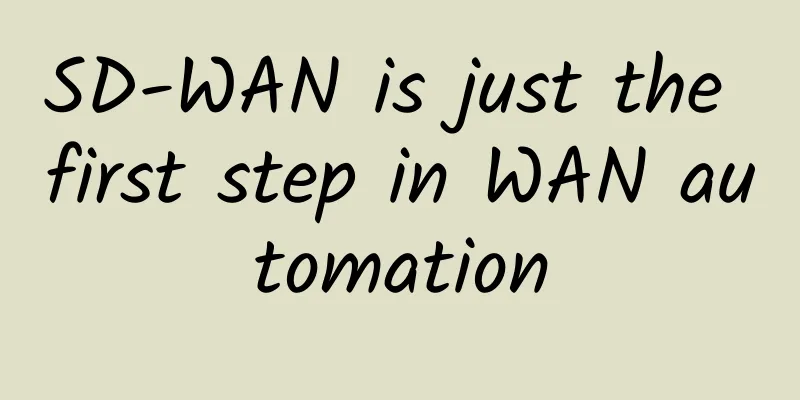This article will help you understand the technical principles of CDN!

|
Hello everyone, I am Brother Shu! I believe everyone has heard of CDN. It feels strange but familiar. Recently, I learned more about CDN and found out how important it is! Today, I will share with you some things about CDN. Browser network requestTo understand CDN, we must first understand the process of a browser sending a request. The overall process is shown in the figure below. Browser network request process
After such a complex process, the user can see the page content. But in fact, in the 6th and 7th steps, there are also very complex processes in between. In order to express it more clearly, we can divide this process into 3 main nodes, as shown in the figure below. Server data transmission process The website server passes through the public network exit, then through the long-distance backbone network, and finally through the user's broadband modem to reach the user's local area network, and finally reaches the browser of the user's computer. Among them, long-distance backbone network transmission is the most time-consuming. It needs to pass through the computer room where the website server is located, the backbone network, the metropolitan area network where the user is located, the access network where the user is located, etc., and its physical transmission distance is very far. In this case, if the data transmitted is very large and the number of users accessing is particularly large, there will be a long delay, affecting the user experience. At the same time, each request for data requires a long data transmission, which is a burden for the long-distance backbone network. The scenario I just mentioned is very vividly illustrated by the Spring Festival ticket rush. When we rush to buy tickets during the Spring Festival, we will log on to the 12306 website, which must have a lot of picture resources. At this time, there may be 100 million people requesting the same picture at the same time. At this time, if we follow the above process to request image data once, it will generate 100 million network data transmissions, which is a disaster for our entire country's Internet infrastructure! But the fact is: 12306 doesn’t seem to be down! So how do they solve this problem? The answer is: CDN! What is CDN?In fact, CDN means content distribution network, and its full name in English is Content Delivery Network. Simply put, CDN can store data in advance in the data node closest to the user, thereby avoiding long-distance travel through the long-distance backbone network, ultimately achieving the purpose of reducing the burden on the backbone network and increasing access speed. According to the above scenario, if there is no CDN, each request needs to go from the website server to the public network exit, long-distance backbone network, user access LAN, and finally reach the browser. But with CDN, it may become as follows: CDN Cache Server When the browser requests image data, it will first go to the CDN cache server to obtain it. If the data is obtained, it will be returned directly. Otherwise, it will go through the long-distance backbone network and finally reach the website server to obtain the image data. As long as we upload the image to the CDN cache server in advance, we can greatly reduce network traffic and reduce network latency. From the above picture, we may think: Isn't this just adding a server between the long-distance backbone network and the user's LAN? But in fact, this is not the case. CDN actually shortens the distance of requesting data. We know that users may be located all over the country. In order to minimize the delay of network transmission, CDN cache servers are generally set up close to users. For example, a main CDN server is set up in South China, North China, East China, and Southwest China. In this way, users in various regions can directly request the corresponding CDN server without having to travel back and forth across most of China, which greatly improves efficiency! Therefore, when we talk about content distribution network, we should have the following picture in mind: CDN cache servers spread all over the country form our content distribution network. Every time a user requests data, it will go to the CDN server closest to him to request data, thus greatly improving the access speed. How CDN worksAt this point, I believe everyone knows what CDN is. But how CDN is actually combined with DNS is still a bit complicated. After adding CDN, the browser's network request becomes as shown in the following figure. Basic working process of CDN
Websites that use CDN services only need to hand over the domain name resolution rights to the CDN service provider, and then upload the content to be distributed to the CDN to achieve content acceleration! SummarizeFrom this perspective, CDN content distribution network is essentially a bunch of cache servers spread all over the world. By cooperating with DNS, it finds a CDN cache server closest to the user and then distributes the data to the user quickly. Through CDN technology, we not only reduced the traffic burden on the overall backbone network, but also improved the user experience. It really kills two birds with one stone! |
<<: Comparison and conversion between IF sampling and IQ sampling
>>: What is 5G RedCap, and can it save cellular IoT?
Recommend
How can you avoid anxiety when doing SaaS?
1. The harder you work, the more anxious you beco...
Ten areas you must know about 5G
The development of 5G is in full swing, and it ca...
Will there be any problems if the algorithms on both ends of a switch link aggregation are inconsistent?
What is Link Aggregation? Link aggregation is a t...
The current status of 5G and new initiatives of the three major telecommunications operators
After entering 2021, the movement of 5G construct...
From "manufacturing" to "intelligent manufacturing", how Qingdao Kute achieved a brilliant transformation
[51CTO.com original article] Enterprise digital t...
Reject poor digital experience! Riverbed creates agile and visual management solutions
According to an IDC report, by 2018, 67% of the w...
The future of optical communications: innovation and integration of PON technology
Author | Heye Review | Chonglou With the continuo...
Will Wi-Fi 7 be a revolution?
A Google search for “famous members of Generation...
The battle between 4G+ and all-network service triggered by mysterious letter
Recently, a local company of a certain operator s...
Maxthon Hosting 20% off: Los Angeles Triple Network CN2 GIA Line Monthly Payment Starting from 54 Yuan, 2G Memory/30G SSD/100M Bandwidth
Aoyozhuji is a long-established foreign VPS servi...
To help students' future, Ruijie Smart Cloud Classroom creates a new teaching model
[51CTO.com original article] Recalling the scene ...
FCC authorizes first batch of 6GHz WiFi devices
The FCC has reportedly authorized the first batch...
Where is the entrance to 5G message service? You may not think of it
Since the Ministry of Industry and Information Te...
Storage requirements for reliable 5G gateways in industrial systems
Manufacturing and production are being revolution...
Ministry of Industry and Information Technology: The number of 5G package users has exceeded 350 million
[[395563]] The State Council Information Office h...









